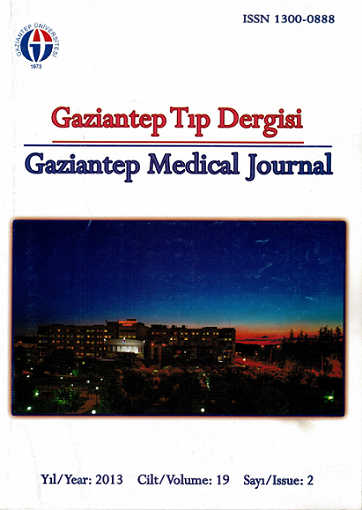Postpartum discharge readiness situation of women who had vaginal deliveries
Vajinal doğum yapan kadınların hastane taburculuğuna hazır oluşluk durumu
DOI:
https://doi.org/10.5455/GMJ-30-2012-115Keywords:
Education, patient discharge, postnatal careAbstract
This research was planned to evaluate postpartum discharge readiness situation of women who had vaginal deliveries at hospital as being a descriptive, cross sectional study. This research was made in a state hospital between 01.03.2012-01.04.2012 to 110 women who had vaginal deliveries. In data collection, individual data collection form, Readiness for Hospital Discharge Scale–New Mother Form (RHD-NMF) was used. The average age of participants was 25.30±5.32 and 38.2% of them have primary school education and 51.8% of them lived in the province the longest. 66.4% of mother’s did not receive any information about discharge and 31.8% of them took it from nurses and nursing students. The first three mostly information given subjects to mothers before discharge are 47.3% baby's gas extraction, 46.4% perineal cleaning of the baby, 40.9% umbilical cord care and least information given subject is 87.3% postpartum exercises. 41.8% of the mothers stated that who helped them the most in the baby care is mothers in laws. 74.5% of the participants stated that they feel ready themselves for hospital discharge. The mean score of RHD-NMF was 142.09±43.76, respectively the mean scores of subscales are: personal status 52.56±12.82, knowledge status 44.63±17.97, ability status 19.04±7.75, expected support 25.85±11.15. According to our study results, although more than half of mothers feel themselves ready for discharge, their scale scores were found moderate, their ability and expected support subscale scores were found lower. Mothers should be given more extensive information by health staff before discharged.
Metrics
References
World Health Organization (WHO). Pospartum care of the mother and newborn: a pratical guide. WHO/RHT/MSM, Geneva 1998; 98/3:8-58.
Sword W, Watt S. Learning needs of postpartum women: does socioeconomic status matter? Birth 2005; 32(2): 86-92.
Yıldız D. Doğum sonrası dönemde annelerin bebek bakımı konusunda danışmanlık gereksinimleri ve yaklaşımlar. Gülhane Tıp Derg 2008;50(4):294-8.
Karaçam Z. Normal postpartum dönemin fizyolojisi ve bakımı. Kadın sağlığı. Ed. Şirin A, Kavlak O. 1. basım. Bedray Basın Yayıncılık, İstanbul, 2008;708- 759.
Weiss ME, Ryan P, Lokken L. Validity and relialibility of the perceived readiness for discharge after birth scale. J Obstet, Gynecol Neonatal Nurs 2006;35(1):34-35.
Akdolun Balkaya N. Postpartum dönemde annelerin bakım gereksinimleri ve ebe-hemşirenin rolü. Cumhuriyet Üniversitesi Hemşirelik Yüksekokulu Dergisi 2002;6(2):42-49.
Akın B, Şahingeri M. Hastane taburculuğuna hazır oluşluk ölçeği-yeni doğum yapmış anne formunun (HTHÖ-YDAF) Türkçe uyarlamasının geçerlilik ve güvenilirliği. Atatürk Üniversitesi Hemşirelik Yüksekokulu Dergisi 2010;13(1):7-14.
Madlon-Kay DJ, DeFor TA. Maternal postpartum health care utilization and the effect of Minnesota early discharge legislation. J Am Board Fam Pract 2005;18(4):307-11.
Britton JR. Postpartum early hospital discharge and follow-up practices in Canada and the United States. Birth 1998;25(3):161-8.
Eaton AP. Early postpartum discharge: recommendations from a preliminary report to Congress. Pediatrics 2001;107(2):400-3.
Malkin JD, Garber S, Broder MS, Keeler E. Infant mortality and early postpartum discharge. Obstet Gynecol 2000;96(2):183-8.
Mandl KD, Homer CJ, Harary O, Finkelstein JA. Effect of reduced postpartum length of stay program on primary care services use by mothers and infants. Pediatrics 2000;106 (4 Suppl): 937-41.
Beydağ KD. Doğum sonu dönemde anneliğe uyum ve hemşirenin rolü. TSK Koruyucu Hekimlik Bülteni 2007;6(6):479-84.
Duman NB. Postpartum erken taburculuk sonrası evde bakım. TSK Koruyucu Hekimlik Bülteni 2009;8(1):73-82.
Gölbaşı Z. Postpartum dönemde erken taburculuk, evde bakım hizmetleri ve hemşirelik. Cumhuriyet Üniversitesi Hemşirelik Yüksekokulu Dergisi 2003;7(2):15-22.
Chalmers B, Mangiaterra V, Porter R. WHO principles of perinatal care: the essential antenatal, perinatal and postpartum course. Birth 2001;28(3):202-7.
Taşkın L. Doğum ve Kadın Sağlığı Hemşireliği. IX. Baskı. Sistem Ofset Matbaacılık, Ankara; 2009; 351-424.
Chung F. Discharge criteria- a new trend. Can J Anaesth 1995; 42(11):1056-8.
Weiss ME, Piacentine LB. Psychometric properties of the readiness for hospital discharge scale. J Nurs Meas 2006;14(3):163-80.
Weiss ME, Ryan P, Lokken L, Nelson M. Length of stay after vaginal birth: sociodemographic and readiness-for-discharge factors. Birth 2004;31(2):93-101.
Naing L, Winn T, Rusli BN. Practical issues in calculating the sample size for prevalence studies. Arch Orofac Sci 2006;1(1):9-14.
Gözüm S, Kiliç D. Health problems related to early discharge of Turkish women. Midwifery 2006;21(4):371-8.
Weiss ME, Lokken L. Predictors and outcomes of postpartum mothers' perceptions of readiness for discharge after birth. J Obstet Gynecol Neonatal Nurs 2009;38(4):406-17.
Arslan F, Uzun Ş. Hemşirenin postnatal eğitim ve danışmanlık hizmetlerinin incelenmesi, Turkiye Klinikleri J Med Sci 2008;28(5):736-42.
Christie J, Poulton BC, Bunting BP. An integrated mid-range theory of postpartum family development: a guide for research and practice. J Adv Nurs 2008;61(1):38-50.
Edwards NC, Sims-Jones N. A randomized controlled trial of alternative approaches to community follow-up for postpartum women. Can J Public Health 1997;88(2):123-8.
Weiss ME, Yakusheva O, Bobay K. Nurse and patient perceptions of discharge readiness in relation to postdischarge utilization. Med Care 2010;48(5):482-6.
Bowman KG, Ruchala PL. A comparison of the postpartum learning needs of adolescent mothers and their mothers. J Obstet Gynecol Neonatal Nurs 2006;35(2):250-6.
Lugina HI, Nyström L, Christensson K, Lindmark G. Assessing mothers’ concerns in the postpartum period: methodological issues. J Adv Nurs 2004;48(3):279-90.
Bernstein HH, Spino C, Baker A, Slora AJ, Touloukian CI, McCormick MC. Postpartum discharge; do varying perceptions of readiness impact health outcomes. Ambul Pediatr 2002;2(5): 388-95.
Downloads
Published
How to Cite
Issue
Section
License
Copyright (c) 2023 European Journal of Therapeutics

This work is licensed under a Creative Commons Attribution-NonCommercial 4.0 International License.
The content of this journal is licensed under a Creative Commons Attribution-NonCommercial 4.0 International License.


















